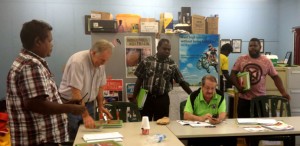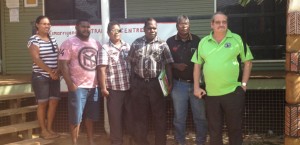The main thing to emerge at Ntaria in the last period of the project was that people identified social issues as inhibiting development in the community. This concern ranges across people of all ages and across agencies. It includes concern about bullying/ teasing, how children are cared for, domestic and family violence, alcohol use and abuse, partying, loud noise, dangerous driving. People are very interested in finding ways to do something about these issues, however there is no consensus as to how to go about it, nor is there agreement as to what lies at the heart of the problems. For example, some people think that there are not enough jobs and that people are idle because of a lack of opportunity, and so think that Tjuwanpa (the local CDP agency) should do more to support people and help them get jobs. Others feel that there are work opportunities in the community and feel that people are not taking them up due to the fact that they are not motivated.
Discussion about these disparate but related issues coalesced with a sense that some way of bringing them together was required. This needed thoughtful and in-depth discussion and some people thought that Wurla Nyinta might be able to take on this role. However it was also noted that Wurla Nyinta’s capacity to undertake this coordination work has been compromised since the demise of the LIP. As such one proposal that has been put forth for consideration is for the Wurla Nyinta to work in partnership with an organisation that can seek funding to initiate a LIP style process to identify critical community issues and to develop actions plans to put them into place.
Such a process may also work into another possibility raised during the project, that of forming an incorporated body that would then be able apply for funding to undertake projects in the community. Again Wurla Nyinta was identified as a potential body to take on this role, however people were aware that such a move should be undertaken cautiously, noting that if it were to become an incorporated entity that much work would be required to negotiate the governance arrangements so that it could deliver community benefit outcomes.
To date the following have been discussed in terms of next steps:
- Representative of Tangentyere attend a Wurla Nyinta meeting to provide final feedback ;
- Discuss and gauge support amongst all Wurla Nyinta members for their interest in developing a LIP style document around current issues. If there is interest (and preliminary discussions indicate that there is) then;
- Hold subsequent meetings to determine an action plan for the development of a LIP style document and to formalise partnership arrangements with an appropriate body.


 It was important to prepare people for the learning and the discussion that was to follow. We invested time in encouraging and building the Tiwi people’s confidence and capacity to actively participate in a meaningful and positive way. The shared learning was very cooperative and collaborative in a caring, safe, fun, open and non-authoritarian learning environment which ensured real engagement and learning.
It was important to prepare people for the learning and the discussion that was to follow. We invested time in encouraging and building the Tiwi people’s confidence and capacity to actively participate in a meaningful and positive way. The shared learning was very cooperative and collaborative in a caring, safe, fun, open and non-authoritarian learning environment which ensured real engagement and learning.